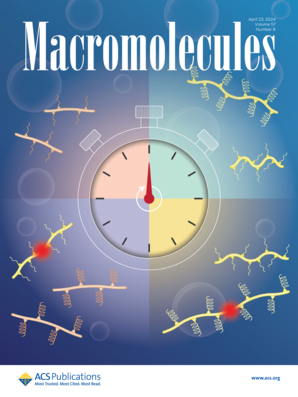Long-Durability Poly(dibenzofuran-co-terphenyl N-methylimidazole) Copolymer Membranes for High-Temperature Polymer Electrolyte Membrane Fuel Cells
IF 5.1
1区 化学
Q1 POLYMER SCIENCE
引用次数: 0
Abstract
Phosphoric acid (PA)-doped polybenzimidazoles (PBIs) are a state-of-the-art membrane for high-temperature polymer electrolyte membrane fuel cells (HT-PEMFCs). Herein, we develop a new series of imidazole-containing copolymers with π-conjugated structures and multiple hydrogen bonding sites via straightforward polymerization of dibenzofuran, p-terphenyl, and 1-methyl-2-imidazolecarboxaldehyde. The high reactivity of the dibenzofuran monomer provides P(BFx%-TPy%-Im) copolymers with high viscosity, while the π-conjugated and hydrophilic furan units also serve as additional PA-binding sites that facilitate the acid doping and proton conduction. The resulting P(BF20%-TP80%-Im)/202%PA membrane demonstrates exceptional performance in H2–O2 and H2–air fuel cells, achieving peak power densities of 1085 and 539 mW cm–2 at 180 °C, respectively, under ambient pressure and humidification. Notably, the H2–air cell equipped with this membrane shows remarkable stability, maintaining the high performance at 400 mA cm–2 and 180 °C, with a voltage decay rate as low as 4.3 μV h–1 over 720 h, likely the best durability result under these highly stressed conditions.

高温聚合物电解质膜燃料电池用长寿命聚(二苯并呋喃-共terphenyl n-甲基咪唑)共聚物膜
磷酸(PA)掺杂聚苯并咪唑(pbi)是一种用于高温聚合物电解质膜燃料电池(ht - pemfc)的新型膜。本文以二苯并呋喃、对terphenyl和1-甲基-2-咪唑甲醛为原料,直接聚合制备了一系列具有π共轭结构和多个氢键位点的新型含咪唑共聚物。二苯并呋喃单体的高反应活性提供了具有高粘度的P(BFx%-TPy%-Im)共聚物,而π共轭和亲水性呋喃单元也作为额外的pa结合位点,促进酸掺杂和质子传导。所得到的P(BF20%-TP80%-Im)/202%PA膜在H2-O2和h2 -空气燃料电池中表现出优异的性能,在环境压力和加湿条件下,在180°C下分别达到1085和539 mW cm-2的峰值功率密度。值得注意的是,该膜的h2 -空气电池表现出了显著的稳定性,在400 mA cm-2和180°C下保持了高性能,在720 h内电压衰减率低至4.3 μV h - 1,可能是在这些高应力条件下的最佳耐久性结果。
本文章由计算机程序翻译,如有差异,请以英文原文为准。
求助全文
约1分钟内获得全文
求助全文
来源期刊

Macromolecules
工程技术-高分子科学
CiteScore
9.30
自引率
16.40%
发文量
942
审稿时长
2 months
期刊介绍:
Macromolecules publishes original, fundamental, and impactful research on all aspects of polymer science. Topics of interest include synthesis (e.g., controlled polymerizations, polymerization catalysis, post polymerization modification, new monomer structures and polymer architectures, and polymerization mechanisms/kinetics analysis); phase behavior, thermodynamics, dynamic, and ordering/disordering phenomena (e.g., self-assembly, gelation, crystallization, solution/melt/solid-state characteristics); structure and properties (e.g., mechanical and rheological properties, surface/interfacial characteristics, electronic and transport properties); new state of the art characterization (e.g., spectroscopy, scattering, microscopy, rheology), simulation (e.g., Monte Carlo, molecular dynamics, multi-scale/coarse-grained modeling), and theoretical methods. Renewable/sustainable polymers, polymer networks, responsive polymers, electro-, magneto- and opto-active macromolecules, inorganic polymers, charge-transporting polymers (ion-containing, semiconducting, and conducting), nanostructured polymers, and polymer composites are also of interest. Typical papers published in Macromolecules showcase important and innovative concepts, experimental methods/observations, and theoretical/computational approaches that demonstrate a fundamental advance in the understanding of polymers.
 求助内容:
求助内容: 应助结果提醒方式:
应助结果提醒方式:


